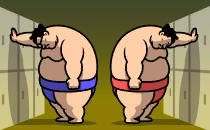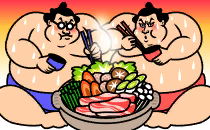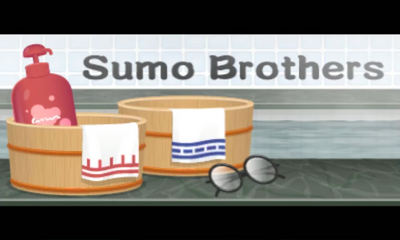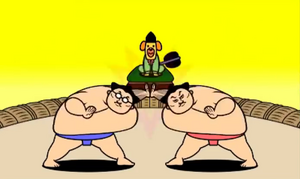Sumo Brothers: Difference between revisions
Jump to navigation
Jump to search
m (there's no need to point it out) |
No edit summary |
||
| Line 56: | Line 56: | ||
==Trivia== | ==Trivia== | ||
*This is one of the [[Rhythm Games]] to have vocal noises in the background, rather than actual lyrics. Other games like this are [[Love Lab]] and [[Pajama Party]]. | *This is one of the [[Rhythm Games]] to have vocal noises in the background, rather than actual lyrics. Other games like this are [[Love Lab]] and [[Pajama Party]]. | ||
*This was the last song sung in game by Tsunku, before one his vocal cords got removed. | |||
*The finishing poses depict two real-life paintings in the background: | *The finishing poses depict two real-life paintings in the background: | ||
**The first painting is widely known as ''Ōtani Oniji III in the Role of the Servant Edobei'', painted by [[wikipedia:Sharaku|Tōshūsai Sharaku]] in 1794. | **The first painting is widely known as ''Ōtani Oniji III in the Role of the Servant Edobei'', painted by [[wikipedia:Sharaku|Tōshūsai Sharaku]] in 1794. | ||
Revision as of 19:32, 18 April 2022
| Sumo Brothers |
| You and your brother are sumo wrestlers in training. You also need to practice doing cool poses. |
Sumo Brothers (ごっつぁん兄弟?, Gottsu~an Kyōdai) is the 4th Rhythm Game of Lush Tower (31st overall) in Rhythm Heaven Megamix.
Gameplay
The player controls one of the Sumo Brothers, who are competing against each other in a sumo contest. The player must follow the rhythm given by Inu-Sensei as follows:
- The hand slap (「はり手」?, "Hari-te"): following the "Ton Ton Ton Ton" (「トントントントン」?) cue, the brothers slap each other's hands on every beat.
- The stomping (「シコ」?, "Shiko"): following the "Kon, Kon" (「コン、コン」?) cue, the brothers stomp the ground every other beat.
- The finishing pose (ポーズ?, Pōzu): following the "Pii!" (「ピーー!」?) cue, the brothers strike a pose.
Controls
- Ⓐ/Tap: Slap/stomp
- Ⓑ/Tap: Pose
Timing Display
- Perfect!/Ace!?: When slapping, the brothers' hands collide together, making a slapping sound. When stomping, the brothers stomp in unison, creating a strong stomping sound. When posing, the brothers pose in unison, with a painting and confetti in the background.
- Early!/Late!?: In each action, the player performs them out of sync, making a "tick" sound. The player's eyes open in shock with sweat coming down while Inu-Sensei gives an annoyed look. The finishing pose does not show a painting nor confetti.
- Miss...?: When slapping, the player gets pushed backward with a "doink" sound, or otherwise slaps the air if they attempt to slap off the beat. When stomping, the player falls backward with a "doink" sound. When posing, the brothers humurously turn in awkward positions. The finishing pose does not show a painting nor confetti. In all cases, Inu-Sensei gives an annoyed look.
Results
| Inu-Sensei's Teachings | |
|---|---|
| Don't be shy with the slaps. Sloppy stomping... More discipline needed with your posing... | |
| Eh. Passable. | |
| Slick slaps. Solid stomping! Priceless posing. |
Epilogue

|

|

|
| We...are the Sumo Bros... | We are the Sumo Bros. | WE ARE THE SUMO BROS! |
Rhythm Item
| Fake Glasses | Vision Quest |
|---|---|
 |
People kept mistaking me for my brother and vice versa, so I started wearing glasses. Then I noticed ladies paid more attention to me with glasses. Don't tell my brother. |
Skill Star
The Skill Star appears during the two consecutive poses.
Challenge Land
Sumo Brothers appears in the following Challenge Train courses:
Appearances
Video
Trivia
- This is one of the Rhythm Games to have vocal noises in the background, rather than actual lyrics. Other games like this are Love Lab and Pajama Party.
- This was the last song sung in game by Tsunku, before one his vocal cords got removed.
- The finishing poses depict two real-life paintings in the background:
- The first painting is widely known as Ōtani Oniji III in the Role of the Servant Edobei, painted by Tōshūsai Sharaku in 1794.
- The second painting that appears is known as The Great Wave off Kanagawa, painted by Katsushika Hokusai in 1831. This painting is often considered the most recognizable work of Japanese art in the world.
In Other Languages
| Language | Name | Meaning |
|---|---|---|
| ごっつぁん兄弟 | Gottsan Brothers ("Gottsan" is a sumo greeting meaning "thank you") | |
| Sumo Brothers | ||
| Sumo Brothers | ||
| Frères sumo | Sumo brothers | |
| Sumo para dos | Sumo for two | |
| Gemelli del sumo | Sumo twin | |
| Sumo Brothers[1] | ||
| 스모 형제 | Sumo Brother |
References
- ↑ Rhythm Paradise Megamix Back Cover (Spanish/Portuguese)
|







